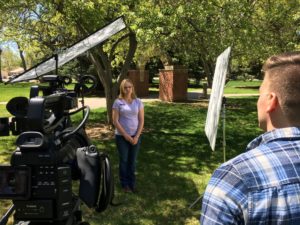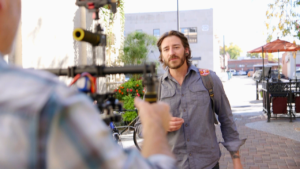
When considering your next Testimonial-Based program, here are a few questions to ask yourself before starting:
Who is going to be in your video? If possible, it’s best to pre-interview them to make sure they are a good candidate – articulate, friendly, and comfortable doing a testimonial. At this time work with them to craft their testimonial to get maximum impact.
What story do you want them to tell? A specific example of how your product or service saved the day would be best, but even, in general, the right words from a customer can be worth their weight in gold.
Where and When would you Ideally like to film? Location can play a large part in your narrative. A Contextual location like a factory is great when interviewing a worker – it provides credibility and atmosphere. A green screen set up can have limitless potential for motion graphics, text, charts, or acting as a Neutral backdrop. Also, consider logistical issues such as extraneous noise and possible time limits on the space.
Finally, Why is their story important? This is the most relevant aspect when selecting a person. Most times it will be obvious because they have a compelling story to tell about your company. However, if there are multiple testimonials make sure their stories align and keep the focus on your product or service.
These, 5 W’s – Who, What, Where, When, and Why that we all learned in grade school, are still essential to great storytelling.
There are particular pitfalls to avoid. If possible, provide the questions to your interviewee beforehand and instruct them not to write out responses that they will attempt to memorize. Unless you are using a teleprompter, memorized responses usually are wooden and insincere. Make sure you’re not rushed. It typically takes 30 to 40 minutes for a video crew to set up for each testimonial interview (not including travel time), so make sure you schedule ample time.
 It’s important to note; an interview is not an interrogation it’s a conversation. Most people are not comfortable with cameras, lights, and a microphone hidden in their shirt. Give them time to adjust and feel free to start a casual conversation before the cameras start rolling. Don’t appear flustered if things start out rough – you’re all there for the same reason, so engage in the Conversation and be patient.
It’s important to note; an interview is not an interrogation it’s a conversation. Most people are not comfortable with cameras, lights, and a microphone hidden in their shirt. Give them time to adjust and feel free to start a casual conversation before the cameras start rolling. Don’t appear flustered if things start out rough – you’re all there for the same reason, so engage in the Conversation and be patient.
Testimonial-Based programs are a powerful tool that can have a tremendous impact on the success of your next campaign. Make sure you’re asking the right questions to get the most out of every interview, and every dollar spent.
